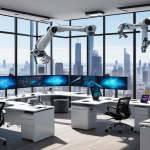10 AI Trends That Will Shape the Next Decade

This article explores significant AI trends expected to influence technology, society, and industries over the next ten years, highlighting innovations and implications for businesses and consumers alike. As we step into this exciting future, the landscape of artificial intelligence is set to evolve dramatically, impacting everything from how we work to how we interact with technology on a daily basis. Imagine a world where machines not only assist us but also enhance our capabilities and decision-making processes. This is the promise of AI, and it’s a journey worth embarking on!
Automation will transform various sectors, enhancing efficiency and productivity. This trend will lead to the rise of intelligent systems capable of performing complex tasks, ultimately reshaping the workforce landscape. Think about it: tasks that once took hours can now be completed in minutes, freeing up human minds for more creative and strategic endeavors. However, this shift also raises questions about job displacement and the future of work. Will we see a world where humans and machines collaborate seamlessly? The answer lies in how we adapt to these changes.
The integration of AI in healthcare will revolutionize diagnostics, treatment plans, and patient care. From predictive analytics that forecast health issues before they arise to personalized medicine tailored to individual genetic profiles, AI’s role will significantly enhance health outcomes. Imagine walking into a clinic and having a machine analyze your health data in real-time, providing doctors with insights that lead to faster, more accurate treatments. This is not science fiction; it’s the future of medicine!
Natural language processing (NLP) will see remarkable advancements, enabling machines to understand and generate human language more effectively. This will improve customer interactions and streamline communication processes. For instance, chatbots will become even more sophisticated, handling inquiries with a level of understanding that feels almost human. The potential for businesses to enhance customer service with AI-driven solutions is immense, and it’s an exciting area to watch.
As AI technologies evolve, ethical considerations and regulatory frameworks will become crucial. Discussions surrounding data privacy, bias, and accountability will shape the responsible development of AI systems. Companies will need to navigate these waters carefully, ensuring that they not only innovate but do so in a way that respects individual rights and societal norms. It’s a balancing act that will define the next decade of AI.
AI will play a pivotal role in enhancing cybersecurity measures. By automating threat detection and response, AI can help organizations better protect sensitive information and mitigate risks. As cyber threats become more sophisticated, relying on human oversight alone is no longer sufficient. AI can analyze vast amounts of data in real-time, identifying patterns that humans might miss. This capability is essential in our increasingly digital world.
| AI Trend | Impact |
|---|---|
| Increased Automation | Enhanced efficiency and productivity |
| AI in Healthcare | Revolutionized diagnostics and treatment |
| NLP Advancements | Improved customer interactions |
| AI Ethics | Responsible AI development |
| AI and Cybersecurity | Better protection against threats |
In conclusion, the next decade promises to be a thrilling era for AI, with trends that will not only shape industries but also redefine our daily lives. As we embrace these changes, it’s crucial to stay informed and engaged, ensuring that we harness the power of AI responsibly and ethically. After all, the future is not something we enter; it’s something we create together!
![10 AI Trends That Will Shape the Next Decade 14 [Increased Automation]](https://www.digitalai.news/wp-content/uploads/2025/02/10-ai-trends-that-will-shape-the-next-decade_1.png)
[Increased Automation]
In today’s rapidly evolving world, increased automation is not just a trend; it’s a revolution that is reshaping various sectors. Imagine a world where mundane tasks are effortlessly handled by intelligent systems, freeing up human resources to focus on more complex and creative endeavors. This shift towards automation is driven by advancements in technology, particularly in artificial intelligence (AI), which enables machines to perform tasks that were once thought to require human intelligence.
As we look towards the next decade, the impact of automation will be profound. Industries such as manufacturing, healthcare, and finance are already witnessing the benefits of this transformation. For instance, automated systems can now manage supply chains, predict maintenance needs, and even assist in diagnosing medical conditions. The potential for improved efficiency and productivity is enormous. Companies that embrace these technologies will not only streamline operations but also gain a competitive edge in the market.
However, it’s essential to understand that with great power comes great responsibility. The rise of automation raises questions about the future of work. Will machines replace human jobs? While some roles may become obsolete, new opportunities will emerge, requiring a workforce skilled in managing and collaborating with these intelligent systems. This shift will necessitate a focus on retraining and upskilling employees to thrive in an automated environment.
To illustrate the impact of increased automation, consider the following table that highlights key sectors and their anticipated changes due to automation:
| Industry | Impact of Automation |
|---|---|
| Manufacturing | Smart factories with predictive maintenance and automated quality control. |
| Healthcare | AI-driven diagnostics and robotic surgeries improving patient outcomes. |
| Finance | Automated trading algorithms and risk assessment tools enhancing efficiency. |
Increased automation will also lead to the creation of new job categories that focus on overseeing automated systems, data analysis, and AI development. Here are some roles that may emerge:
- AI System Managers
- Data Analysts
- Automation Consultants
In conclusion, the future of work will be a blend of human and machine collaboration. As we embrace increased automation, we must also be proactive in addressing the challenges it presents. Companies, governments, and educational institutions need to work together to ensure that the workforce is prepared for this new era. By investing in education and training, we can create a future where humans and machines coexist, driving innovation and enhancing productivity.
![10 AI Trends That Will Shape the Next Decade 15 [AI in Healthcare]](https://www.digitalai.news/wp-content/uploads/2025/02/10-ai-trends-that-will-shape-the-next-decade_2.png)
[AI in Healthcare]
The integration of AI in healthcare is not just a trend; it’s a revolution that promises to redefine how we approach medical care. Imagine walking into a clinic where your medical history is instantly analyzed by an intelligent system that can predict your health risks before you even sit down for a consultation. Sounds futuristic, right? But this is the reality that AI is paving the way for, enhancing diagnostics, treatment plans, and overall patient care.
One of the most exciting aspects of AI in healthcare is its ability to process vast amounts of data at lightning speed. For instance, AI algorithms can analyze medical images, like X-rays and MRIs, with a level of precision that often surpasses human capabilities. This not only leads to faster diagnoses but also significantly reduces the chances of human error. According to a recent study, AI can improve diagnostic accuracy by up to 30% compared to traditional methods.
| AI Applications in Healthcare | Benefits |
|---|---|
| Predictive Analytics | Identifies potential health risks and improves preventive care. |
| Personalized Medicine | Tailors treatment plans based on individual patient data. |
| Robotic Surgery | Enhances precision and reduces recovery times. |
| Virtual Health Assistants | Provides 24/7 support and information to patients. |
Moreover, the rise of AI-driven tools in healthcare is transforming patient engagement. Virtual health assistants and chatbots are becoming commonplace, offering patients immediate responses to their queries and guiding them through their treatment journeys. This not only improves patient satisfaction but also allows healthcare professionals to focus on more complex cases that require human touch and expertise.
However, the integration of AI in healthcare is not without its challenges. Ethical considerations, such as data privacy and algorithmic bias, need to be addressed to ensure that AI systems are developed responsibly. As we embrace this technology, it’s crucial to foster discussions around accountability and transparency to build trust among patients and healthcare providers alike.
In conclusion, the future of AI in healthcare is bright and full of potential. As we continue to innovate, the collaboration between technology and healthcare professionals will lead to improved health outcomes and a more efficient healthcare system. The question remains: are we ready to embrace this change and harness the power of AI for the greater good?
“AI is not just a tool; it’s a partner in our journey towards better health.”
![10 AI Trends That Will Shape the Next Decade 16 [Natural Language Processing Advancements]](https://www.digitalai.news/wp-content/uploads/2025/02/10-ai-trends-that-will-shape-the-next-decade_3.png)
[Natural Language Processing Advancements]
Natural Language Processing (NLP) is on the brink of a revolution, and it’s about to change the way we interact with technology. Imagine having a conversation with your devices as if they were your best friends. That’s the future NLP is steering us towards! With advancements in machine learning and deep learning, machines are becoming increasingly adept at understanding and generating human language, making our interactions smoother and more intuitive.
One of the most exciting developments in NLP is the rise of contextual understanding. Algorithms are now able to grasp the nuances of human language, including slang, idioms, and even emotions. This means that chatbots can respond more appropriately to customer inquiries, leading to enhanced user satisfaction. For instance, a customer asking about a product can receive personalized recommendations based on their previous interactions, making the experience feel more tailored and engaging.
To illustrate the impact of these advancements, consider the following table that showcases some key NLP technologies and their applications:
| Technology | Application |
|---|---|
| Sentiment Analysis | Understanding customer feedback and emotions in reviews |
| Chatbots | Providing 24/7 customer support and assistance |
| Speech Recognition | Transcribing spoken words into text for accessibility |
| Machine Translation | Breaking down language barriers in global communication |
Moreover, the ability of NLP to analyze vast amounts of data quickly is a game changer for businesses. By utilizing predictive analytics, companies can anticipate customer needs and trends, enabling them to stay ahead of the competition. For example, marketers can tailor their campaigns based on insights derived from customer interactions, leading to higher conversion rates.
But with great power comes great responsibility. As we embrace these advancements, we must also consider the ethical implications. Questions about data privacy and algorithmic bias are critical. How do we ensure that these systems are fair and do not perpetuate existing inequalities? The conversation around NLP ethics is becoming increasingly important as we move forward.
In summary, the advancements in Natural Language Processing are not just technical feats; they are paving the way for a more connected and responsive world. As we witness these innovations unfold, it’s essential to stay informed and engaged in discussions about their implications. After all, the future of communication is not just about technology; it’s about how we connect with each other in a meaningful way.
So, are you ready to embrace the NLP revolution? The next decade promises to be an exciting journey into a world where machines understand us better than ever before!
![10 AI Trends That Will Shape the Next Decade 17 [AI Ethics and Regulation]](https://www.digitalai.news/wp-content/uploads/2025/02/10-ai-trends-that-will-shape-the-next-decade_4.png)
[AI Ethics and Regulation]
As artificial intelligence continues to evolve at a breakneck pace, the conversation surrounding AI ethics and regulation has never been more critical. With the power of AI comes great responsibility, and it’s essential to ensure that these technologies are developed and deployed in ways that are ethical and beneficial to society. The increasing reliance on AI raises significant ethical questions: Who is accountable when AI systems make mistakes? How do we ensure data privacy and prevent bias in algorithms? These are just a few of the pressing issues that need to be addressed.
One of the primary concerns in the realm of AI ethics is data privacy. As AI systems often require vast amounts of data to function effectively, safeguarding this data is paramount. Organizations must navigate the delicate balance between utilizing data for innovation and protecting individuals’ rights. Furthermore, bias in AI algorithms can lead to unfair treatment of certain groups, perpetuating existing inequalities. It is crucial to implement robust frameworks that promote transparency and fairness in AI decision-making processes.
To tackle these challenges, many experts advocate for the establishment of regulatory frameworks that govern the development and use of AI technologies. These regulations should encompass various aspects, including:
- Accountability: Defining who is responsible for AI outcomes.
- Transparency: Ensuring AI systems are understandable and their processes are visible to users.
- Fairness: Preventing discrimination and bias in AI algorithms.
- Security: Protecting AI systems from malicious attacks and data breaches.
Moreover, organizations can benefit from adopting ethical AI frameworks that guide their practices. A well-structured approach can foster a culture of responsibility and trust. The table below outlines some key components of an effective AI ethics framework:
| Component | Description |
|---|---|
| Transparency | Clear communication about how AI systems work and their decision-making processes. |
| Accountability | Establishing who is liable for AI actions and ensuring mechanisms for redress. |
| Bias Mitigation | Implementing strategies to identify and reduce bias in AI algorithms. |
| Security Measures | Protecting AI systems from vulnerabilities and ensuring the safety of user data. |
In conclusion, the future of AI hinges on our ability to navigate the complex landscape of ethics and regulation. As we embrace these powerful technologies, it is imperative that we prioritize ethical considerations and develop comprehensive regulatory frameworks. By doing so, we can harness the potential of AI while safeguarding the rights and well-being of individuals and society as a whole.
“With great power comes great responsibility.” – A reminder that the advancements in AI must be matched by a commitment to ethical practices.
As we look ahead, the dialogue around AI ethics and regulation will be pivotal in shaping a future where technology serves humanity, rather than undermining it. Let’s ensure that the innovations of tomorrow are built on a foundation of trust, fairness, and accountability.
![10 AI Trends That Will Shape the Next Decade 18 [AI and Cybersecurity]](https://www.digitalai.news/wp-content/uploads/2025/02/10-ai-trends-that-will-shape-the-next-decade_5.png)
[AI and Cybersecurity]
In today’s digital landscape, where cyber threats are becoming increasingly sophisticated, the role of AI in cybersecurity is more critical than ever. As organizations strive to protect sensitive data and maintain trust, leveraging artificial intelligence is not just an option; it’s a necessity. Imagine having a vigilant security guard who never sleeps, constantly analyzing patterns and detecting anomalies. That’s what AI brings to the table—24/7 vigilance against potential threats.
AI technologies are revolutionizing how we approach cybersecurity. By utilizing machine learning algorithms, organizations can automate threat detection and response processes, significantly reducing the time it takes to identify and neutralize threats. For instance, traditional security systems often rely on predefined rules to detect intrusions. In contrast, AI systems can learn from past incidents and adapt to new threats, making them far more effective.
Here are some key ways AI enhances cybersecurity:
- Automated Threat Detection: AI can analyze vast amounts of data to identify suspicious activities in real-time.
- Predictive Analytics: By recognizing patterns, AI can predict potential threats before they occur.
- Incident Response: Automated systems can respond to threats faster than human teams, minimizing damage.
Furthermore, the integration of AI in cybersecurity can lead to a significant reduction in false positives. Traditional systems often generate numerous alerts, overwhelming security teams. With AI, the focus shifts to genuine threats, allowing human analysts to concentrate on high-priority issues. This synergy between human expertise and AI efficiency creates a robust defense mechanism.
| AI Cybersecurity Benefits | Traditional Cybersecurity Limitations |
|---|---|
| Real-time threat detection | Delayed response times |
| Adaptive learning capabilities | Static rule-based systems |
| Reduced false positives | High volume of alerts |
| 24/7 monitoring | Limited human oversight |
As we move forward, the collaboration between AI and cybersecurity will only deepen. Organizations must embrace this technology to stay ahead of cybercriminals. However, it’s essential to approach AI implementation responsibly, ensuring that ethical considerations are at the forefront. As highlighted by cybersecurity expert Jane Doe, “AI is a powerful tool, but it must be used wisely to protect our digital future.”
In conclusion, the future of cybersecurity is intertwined with artificial intelligence. By investing in AI-driven solutions, businesses can not only enhance their security posture but also foster a culture of innovation and resilience. As we navigate this ever-evolving landscape, remember: AI is not just a tool; it’s a partner in the fight against cyber threats.
![10 AI Trends That Will Shape the Next Decade 19 [AI in Education]](https://www.digitalai.news/wp-content/uploads/2025/02/10-ai-trends-that-will-shape-the-next-decade_6.png)
[AI in Education]
The integration of AI in education is not just a trend; it’s a revolution that is reshaping how students learn and educators teach. Imagine a classroom where every student receives a personalized learning experience tailored just for them. With AI-driven tools, this is becoming a reality. These technologies are designed to analyze individual learning styles and adapt content accordingly, making education more engaging and effective.
One of the standout features of AI in education is its ability to create adaptive learning platforms. These platforms utilize data analytics to assess students’ strengths and weaknesses, allowing them to progress at their own pace. For instance, if a student struggles with math concepts, the system can provide additional resources and practice problems tailored specifically to that student’s needs. This not only boosts confidence but also enhances overall learning outcomes.
| AI Tools in Education | Benefits |
|---|---|
| Intelligent Tutoring Systems | Provides personalized feedback and assistance to students. |
| Automated Grading | Saves teachers time and provides instant feedback to students. |
| Learning Analytics | Helps educators track student progress and identify areas for improvement. |
Moreover, AI can assist educators by automating administrative tasks. Teachers often find themselves bogged down with grading and paperwork, which takes away valuable time they could spend interacting with students. By utilizing AI for automated grading and managing schedules, educators can focus more on teaching and less on administrative burdens. This shift not only improves teacher satisfaction but also enhances the quality of education students receive.
However, as we embrace these advancements, it’s crucial to consider ethical implications. How do we ensure data privacy for students? How can we prevent biases in AI algorithms that could affect learning outcomes? These questions must be addressed as we move forward. Engaging in discussions about AI ethics in education will be vital to ensure that technology serves all students equitably.
In conclusion, the future of education is bright with the integration of AI technologies. As we continue to innovate and adapt, it’s essential to keep the focus on enhancing student learning experiences. After all, education is not just about imparting knowledge; it’s about nurturing a love for learning and preparing students for a rapidly changing world.
As a parting thought, consider this: “Education is the most powerful weapon which you can use to change the world.” – Nelson Mandela. With AI, we have the opportunity to change education for the better, making it more accessible and effective for everyone.
![10 AI Trends That Will Shape the Next Decade 20 [AI-Powered Customer Experience]](https://www.digitalai.news/wp-content/uploads/2025/02/10-ai-trends-that-will-shape-the-next-decade_7.png)
[AI-Powered Customer Experience]
In today’s fast-paced digital world, AI-powered customer experience is not just a luxury; it’s a necessity. Businesses are increasingly turning to artificial intelligence to enhance how they interact with customers, making every touchpoint more personalized and efficient. Imagine walking into a store where the staff already knows your preferences and can suggest items tailored to your taste—this is the reality that AI is creating in the customer service landscape.
AI technologies like chatbots, predictive analytics, and personalized recommendation engines are revolutionizing customer interactions. For instance, chatbots can provide instant responses to queries, ensuring that customers feel heard and valued. According to a recent study, companies that leverage AI for customer engagement see a 30% increase in customer satisfaction. This is because AI can analyze vast amounts of data to understand customer behavior and preferences, leading to more relevant interactions.
| AI Tools | Benefits |
|---|---|
| Chatbots | 24/7 customer support and instant query resolution. |
| Predictive Analytics | Anticipates customer needs and tailors recommendations. |
| Personalized Marketing | Increases engagement through targeted promotions. |
Moreover, AI can analyze customer feedback in real-time, allowing businesses to adapt their strategies swiftly. This level of responsiveness not only boosts customer loyalty but also drives revenue growth. Think of it as having a crystal ball that reveals what your customers want before they even ask for it!
However, while the benefits of AI in enhancing customer experience are immense, there are also challenges to consider. Issues like data privacy and the need for human oversight remain crucial. Businesses must strike a balance between automation and the personal touch that customers still crave. After all, while AI can analyze data and predict trends, it lacks the emotional intelligence that human representatives bring to the table.
In conclusion, the integration of AI-powered customer experience tools is transforming how businesses engage with their customers. By embracing these technologies, companies can not only meet but exceed customer expectations, creating a win-win situation for both parties. As we move forward, the question remains: Will you adapt to this AI-driven landscape, or will you be left behind?
![10 AI Trends That Will Shape the Next Decade 21 [AI and Sustainability]](https://www.digitalai.news/wp-content/uploads/2025/02/10-ai-trends-that-will-shape-the-next-decade_8.png)
[AI and Sustainability]
In today’s rapidly changing world, the intersection of AI and sustainability is becoming increasingly significant. As we face pressing environmental challenges, the integration of artificial intelligence into sustainability efforts is not just a trend; it’s a necessity. AI technologies are paving the way for innovative solutions that can help us manage resources more efficiently and reduce our ecological footprint. Imagine a world where smart algorithms optimize energy consumption, minimize waste, and contribute to a healthier planet. Sounds incredible, right?
One of the most impactful ways AI contributes to sustainability is through resource management. By analyzing vast amounts of data, AI can identify patterns and suggest improvements in how we use natural resources. For instance, in agriculture, AI-driven tools can monitor crop health, predict yields, and optimize water usage, leading to more sustainable farming practices. This not only helps farmers increase productivity but also conserves precious resources.
| AI Applications | Impact on Sustainability |
|---|---|
| Energy Management Systems | Optimize energy consumption in buildings, reducing waste. |
| Smart Grids | Enhance the efficiency of energy distribution and usage. |
| Predictive Analytics in Waste Management | Improve recycling processes and reduce landfill waste. |
| Climate Modeling | Provide insights for better environmental policies and practices. |
Moreover, AI plays a crucial role in monitoring environmental changes. With the help of machine learning algorithms, we can analyze satellite imagery and sensor data to track deforestation, pollution levels, and wildlife populations. This information is vital for implementing effective conservation strategies. For example, AI can help identify areas at risk of deforestation, allowing organizations to intervene before it’s too late.
In addition to monitoring, AI can also facilitate the development of sustainable technologies. From electric vehicles to renewable energy solutions, AI is at the forefront of innovation. These technologies not only reduce greenhouse gas emissions but also promote a circular economy where resources are reused and recycled. Imagine a future where waste is a thing of the past, and every product is designed with sustainability in mind.
As we move forward, it’s essential to consider the ethical implications of AI in sustainability. While the potential benefits are enormous, we must ensure that AI systems are designed with fairness and accountability in mind. This means addressing issues like data privacy and ensuring that AI solutions do not disproportionately affect vulnerable communities.
In conclusion, the relationship between AI and sustainability is a powerful one. By harnessing the capabilities of artificial intelligence, we can make strides toward a more sustainable future. As we embrace these technologies, let’s remember that the ultimate goal is to create a harmonious balance between human progress and the health of our planet. Together, we can build a world where technology and nature coexist, leading to a brighter, greener tomorrow.
![10 AI Trends That Will Shape the Next Decade 22 [Human-AI Collaboration]](https://www.digitalai.news/wp-content/uploads/2025/02/10-ai-trends-that-will-shape-the-next-decade_9.png)
[Human-AI Collaboration]
The future of work is not about machines replacing humans; rather, it’s about human-AI collaboration. Imagine a world where artificial intelligence acts as an extension of our own capabilities, enhancing our decision-making processes and boosting creativity. This partnership is set to redefine industries and how we interact with technology. By combining human intuition with AI’s analytical prowess, we can tackle complex problems more effectively than ever before.
In various sectors, the synergy between humans and AI will unlock new levels of productivity. For instance, in creative fields, AI can analyze vast amounts of data to identify trends, while humans can infuse their unique insights and emotional intelligence into the creative process. This collaboration can lead to groundbreaking innovations that neither could achieve alone.
Here are some key areas where human-AI collaboration is expected to flourish:
- Healthcare: AI can assist doctors by providing data-driven insights, allowing them to focus on patient care.
- Finance: Financial analysts can leverage AI algorithms to predict market trends, enhancing their decision-making.
- Education: Teachers can use AI tools to tailor learning experiences to individual student needs, improving engagement.
As we embrace this collaborative future, it’s essential to consider the ethical implications. We must ensure that AI systems are designed to augment human capabilities responsibly. This involves addressing concerns such as bias in AI algorithms and ensuring transparency in decision-making processes.
To illustrate the potential of human-AI collaboration, let’s look at a table that highlights the benefits and challenges of this partnership:
| Benefits | Challenges |
|---|---|
| Enhanced productivity and efficiency | Potential job displacement concerns |
| Improved decision-making | Bias and ethical considerations |
| Increased innovation and creativity | Need for ongoing training and adaptation |
In conclusion, the future of human-AI collaboration is bright, but it requires careful navigation. As we harness the power of AI, we must prioritize ethical standards and ensure that technology serves humanity. By doing so, we can create a world where humans and AI work hand-in-hand, driving progress and innovation in ways we have yet to imagine.
“The best way to predict the future is to create it.” – Peter Drucker
As we look forward to this exciting era, let’s embrace the possibilities that lie ahead in human-AI collaboration and work together to shape a future filled with potential.
![10 AI Trends That Will Shape the Next Decade 23 [AI in Finance]](https://www.digitalai.news/wp-content/uploads/2025/02/10-ai-trends-that-will-shape-the-next-decade_10.png)
[AI in Finance]
The finance industry is on the brink of a revolutionary transformation, thanks to the rapid advancements in AI technologies. As financial institutions increasingly embrace these innovations, we can expect a significant shift in how they operate, manage risks, and serve their customers. Imagine a world where algorithms analyze vast amounts of data in seconds, making decisions that would take humans hours or even days. This is not just a dream—it’s happening now!
One of the most exciting aspects of AI in finance is its ability to enhance risk assessment. Traditional methods often rely on historical data and static models, which can be limiting. However, with AI, financial institutions can leverage machine learning algorithms to analyze real-time data, identify patterns, and predict potential risks with remarkable accuracy. This proactive approach enables banks and investment firms to make informed decisions, ultimately leading to better financial health.
| AI Applications in Finance | Description |
|---|---|
| Fraud Detection | AI systems can analyze transaction patterns and flag unusual activities, significantly reducing fraud cases. |
| Algorithmic Trading | AI algorithms can execute trades at optimal times, maximizing profits while minimizing risks. |
| Customer Service Automation | Chatbots powered by AI can handle customer inquiries 24/7, improving service efficiency. |
Moreover, the integration of AI into financial services has led to the rise of personalized banking experiences. By analyzing customer data, AI can offer tailored financial advice, suggest investment opportunities, and even provide budgeting tips that align with individual goals. This level of personalization not only enhances customer satisfaction but also fosters loyalty, as clients feel understood and valued.
However, with great power comes great responsibility. The use of AI in finance raises important ethical considerations. Issues such as data privacy, algorithmic bias, and accountability need to be addressed to ensure that AI systems operate fairly and transparently. Financial institutions must navigate these challenges carefully to maintain trust with their clients.
In conclusion, the impact of AI in finance is profound and far-reaching. As we look ahead, it’s clear that the next decade will see even greater integration of AI technologies in the financial sector. By embracing these innovations, financial institutions can not only improve their efficiency and decision-making processes but also create a more personalized and secure banking experience for their customers.
As the famous quote goes, “In the midst of chaos, there is also opportunity.” The finance industry stands at a crossroads, and those who harness the power of AI will undoubtedly lead the charge into a new era of financial services.
![10 AI Trends That Will Shape the Next Decade 24 [Edge AI]](https://www.digitalai.news/wp-content/uploads/2025/02/10-ai-trends-that-will-shape-the-next-decade_11.png)
[Edge AI]
Edge AI is set to revolutionize the way we process data by bringing computation and data storage closer to the source of data generation. Imagine a world where decisions are made in real-time, without the lag of sending data to a central server. This is the promise of Edge AI, which allows devices to analyze data locally and act upon it immediately. Whether it’s in smart cities, autonomous vehicles, or IoT devices, the implications are vast and transformative.
One of the most significant advantages of Edge AI is its ability to reduce latency. In scenarios where every millisecond counts, such as in autonomous driving or remote surgery, having the processing power right where the data is generated can be a game-changer. Additionally, it decreases bandwidth usage, as less data needs to be transmitted to and from the cloud. This not only saves costs but also enhances privacy and security, as sensitive information can be processed locally.
Furthermore, Edge AI supports a variety of applications across different industries. For instance, in healthcare, wearable devices can monitor patient vitals in real-time, alerting healthcare providers to any anomalies without the need for constant data uploads. In manufacturing, smart machines can predict equipment failures before they happen, reducing downtime and maintenance costs.
| Industry | Application of Edge AI | Benefits |
|---|---|---|
| Healthcare | Real-time patient monitoring | Immediate alerts, improved patient outcomes |
| Manufacturing | Predictive maintenance | Reduced downtime, cost savings |
| Smart Cities | Traffic management | Improved traffic flow, reduced congestion |
| Retail | In-store analytics | Enhanced customer experience, targeted marketing |
As we look forward, it’s clear that Edge AI will play a pivotal role in shaping our technological landscape. With the increasing demand for real-time data processing and the need for greater privacy and security, businesses are beginning to invest heavily in this technology. But what does this mean for the average consumer? It means smarter devices that can intuitively respond to our needs, making our lives easier and more efficient.
In conclusion, Edge AI is not just a trend; it’s a significant leap towards a more connected and responsive world. As we embrace this technology, we can expect to see innovations that will enhance our day-to-day experiences and transform entire industries.
“The future is not something we enter. The future is something we create.” – Leonard I. Sweet
![10 AI Trends That Will Shape the Next Decade 25 [AI in Manufacturing]](https://www.digitalai.news/wp-content/uploads/2025/02/10-ai-trends-that-will-shape-the-next-decade_12.png)
[AI in Manufacturing]
The manufacturing industry is on the brink of a revolution, and at the heart of this transformation is Artificial Intelligence (AI). As companies strive for greater efficiency and productivity, AI technologies are stepping in to streamline operations, reduce costs, and enhance overall performance. Imagine a world where machines not only assist in production but also predict failures before they happen. This is the future that AI in manufacturing promises.
One of the most significant impacts of AI in manufacturing is the rise of smart factories. These facilities leverage AI to create a more interconnected and automated environment. With the help of AI, manufacturers can analyze vast amounts of data in real-time, leading to informed decision-making. The benefits of this integration are numerous, including:
- Predictive Maintenance: AI algorithms can predict when machines are likely to fail, allowing for timely maintenance and reducing downtime.
- Quality Control: AI systems can monitor production quality in real-time, identifying defects faster than human inspectors.
- Supply Chain Optimization: AI can analyze supply chain data to forecast demand and optimize inventory levels, ensuring that resources are used efficiently.
To illustrate the potential of AI in manufacturing, consider the following table that highlights key benefits and their impacts:
| Benefit | Impact |
|---|---|
| Increased Efficiency | Reduction in production time and costs |
| Enhanced Safety | Minimized human error and workplace accidents |
| Data-Driven Insights | Improved decision-making through analytics |
As we delve deeper into the integration of AI in manufacturing, it’s essential to acknowledge the role of human-AI collaboration. Rather than replacing human workers, AI is designed to augment their capabilities. This synergy allows humans to focus on more complex tasks while machines handle repetitive and mundane activities. For instance, a factory worker may operate alongside AI systems that manage inventory levels, freeing them to concentrate on quality assurance and innovation.
In conclusion, the future of manufacturing is bright with AI at the helm. As technology continues to evolve, businesses that embrace AI will not only enhance their operational efficiencies but also drive innovation. The question remains, are you ready to step into this new era of manufacturing powered by AI?
Frequently Asked Questions
- What is the impact of increased automation on the workforce?
Increased automation is set to transform the workforce dramatically. As intelligent systems take over complex tasks, many traditional jobs may be at risk. However, this shift also creates new opportunities in tech-driven roles, requiring workers to adapt and upskill to thrive in a more automated environment.
- How will AI improve healthcare?
AI is revolutionizing healthcare by enhancing diagnostics, personalizing treatment plans, and improving patient care. With tools like predictive analytics, healthcare providers can anticipate patient needs and deliver tailored solutions, ultimately leading to better health outcomes and more efficient care.
- What advancements can we expect in natural language processing?
Natural language processing (NLP) is expected to see significant advancements, allowing machines to understand and generate human language more effectively. This will enhance customer interactions through improved chatbots and communication tools, making it easier for businesses to connect with their audience.
- Why are AI ethics and regulation important?
As AI technologies evolve, ethical considerations and regulatory frameworks become crucial. Discussions around data privacy, bias, and accountability will shape the responsible development of AI systems, ensuring that they are beneficial and fair to all users.
- How does AI enhance cybersecurity?
AI plays a pivotal role in cybersecurity by automating threat detection and response. This allows organizations to better protect sensitive information and mitigate risks, making it harder for cybercriminals to exploit vulnerabilities.
- What role does AI play in education?
AI is increasingly being adopted in education to personalize learning experiences. Adaptive learning platforms can cater to individual student needs, enhancing engagement and improving educational outcomes.
- How can businesses use AI to improve customer experience?
Businesses can leverage AI to enhance customer experiences through personalized recommendations, chatbots, and predictive analytics. These tools help create a more tailored shopping experience, driving customer satisfaction and loyalty.
- In what ways is AI contributing to sustainability?
AI technologies contribute to sustainability efforts by optimizing resource management and reducing waste. Innovations in energy efficiency and environmental monitoring help address global challenges, making operations greener and more efficient.
- What does human-AI collaboration look like?
The future will see greater collaboration between humans and AI, where machines augment human capabilities. This partnership enhances creativity and problem-solving across various domains, leading to innovative solutions and improved outcomes.
- How is AI transforming the finance industry?
AI is increasingly utilized in the finance industry for risk assessment, fraud detection, and algorithmic trading. These advancements streamline operations and improve decision-making processes, making financial services more efficient and reliable.
- What is Edge AI and its benefits?
Edge AI allows data processing closer to the source, reducing latency and bandwidth usage. This trend enables real-time analytics and decision-making in various applications, from smart cities to autonomous vehicles, enhancing overall efficiency.
- How will AI impact manufacturing?
Manufacturing is set to undergo a transformation with AI adoption, leading to smarter supply chains, predictive maintenance, and enhanced production efficiency. This will drive innovation within the industry, making processes more effective and responsive to market demands.













